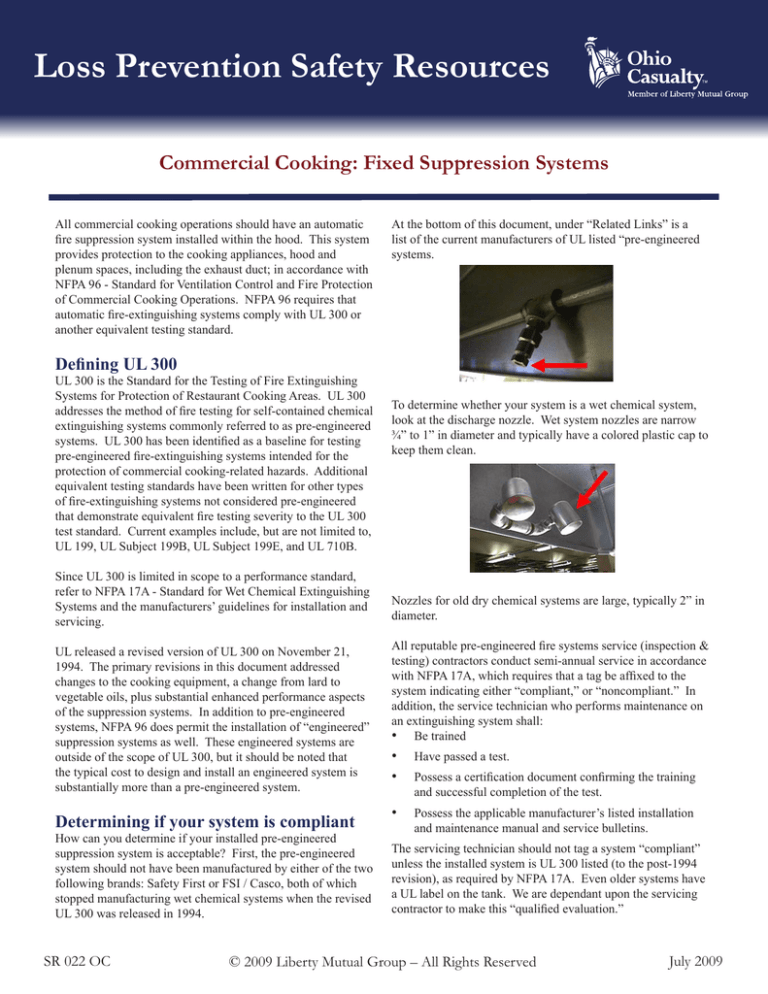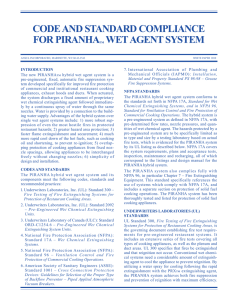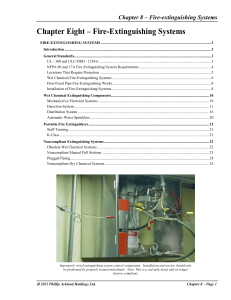
Loss Prevention Safety Resources
Commercial Cooking: Fixed Suppression Systems
All commercial cooking operations should have an automatic
fire suppression system installed within the hood. This system
provides protection to the cooking appliances, hood and
plenum spaces, including the exhaust duct; in accordance with
NFPA 96 - Standard for Ventilation Control and Fire Protection
of Commercial Cooking Operations. NFPA 96 requires that
automatic fire-extinguishing systems comply with UL 300 or
another equivalent testing standard.
At the bottom of this document, under “Related Links” is a
list of the current manufacturers of UL listed “pre-engineered
systems.
Defining UL 300
UL 300 is the Standard for the Testing of Fire Extinguishing
Systems for Protection of Restaurant Cooking Areas. UL 300
addresses the method of fire testing for self-contained chemical
extinguishing systems commonly referred to as pre-engineered
systems. UL 300 has been identified as a baseline for testing
pre-engineered fire-extinguishing systems intended for the
protection of commercial cooking-related hazards. Additional
equivalent testing standards have been written for other types
of fire-extinguishing systems not considered pre-engineered
that demonstrate equivalent fire testing severity to the UL 300
test standard. Current examples include, but are not limited to,
UL 199, UL Subject 199B, UL Subject 199E, and UL 710B.
Since UL 300 is limited in scope to a performance standard,
refer to NFPA 17A - Standard for Wet Chemical Extinguishing
Systems and the manufacturers’ guidelines for installation and
servicing.
UL released a revised version of UL 300 on November 21,
1994. The primary revisions in this document addressed
changes to the cooking equipment, a change from lard to
vegetable oils, plus substantial enhanced performance aspects
of the suppression systems. In addition to pre-engineered
systems, NFPA 96 does permit the installation of “engineered”
suppression systems as well. These engineered systems are
outside of the scope of UL 300, but it should be noted that
the typical cost to design and install an engineered system is
substantially more than a pre-engineered system.
Determining if your system is compliant
How can you determine if your installed pre-engineered
suppression system is acceptable? First, the pre-engineered
system should not have been manufactured by either of the two
following brands: Safety First or FSI / Casco, both of which
stopped manufacturing wet chemical systems when the revised
UL 300 was released in 1994.
SR 022 OC
To determine whether your system is a wet chemical system,
look at the discharge nozzle. Wet system nozzles are narrow
¾” to 1” in diameter and typically have a colored plastic cap to
keep them clean.
Nozzles for old dry chemical systems are large, typically 2” in
diameter.
All reputable pre-engineered fire systems service (inspection &
testing) contractors conduct semi-annual service in accordance
with NFPA 17A, which requires that a tag be affixed to the
system indicating either “compliant,” or “noncompliant.” In
addition, the service technician who performs maintenance on
an extinguishing system shall:
• Be trained
• Have passed a test.
• Possess a certification document confirming the training
and successful completion of the test.
• Possess the applicable manufacturer’s listed installation
and maintenance manual and service bulletins.
The servicing technician should not tag a system “compliant”
unless the installed system is UL 300 listed (to the post-1994
revision), as required by NFPA 17A. Even older systems have
a UL label on the tank. We are dependant upon the servicing
contractor to make this “qualified evaluation.”
© 2009 Liberty Mutual Group – All Rights Reserved
July 2009
Identifying the service provider
A service record tag is attached to the system, either at the
manual pull box or at the cylinder. Again, systems that are
noncompliant are also tagged. It is important to read the tag
and note which tag was installed and whether any notes were
written on the back of the tag. The tag will list the name and
phone number of the service provider. You can contact this
provider directly for confirmation of compliance.
If you have any further questions or concerns, please contact
your Loss Prevention Consultant, who will gladly assist you.
Related Links:
• National Fire Protection Association - www.nfpa.org/
• Underwriter’s Laboratories, Inc. www.ul.com
• Amerex - KP Restaurant System www.amerex-fire.com/
products/product/8
Obvious indicators a fixed suppression does not meet the
current version of UL 300:
• Ansul® - R-102™ Restaurant Fire Suppression Systems
• Installed prior to 11/21/1994
• Noncompliant tag, or a tag
• Ansul® - Piranha® Fire Suppression Systems www.ansul.
www.ansul.com/en/Products/kitchen_sys/kitchen_list.asp
com/en/Products/kitchen_sys/kitchen_piranha.asp
with notes written on the back
indicating items to be corrected
• Dry chemical nozzles and
• Badger Fire Protection - Range Guard www.badgerfire.
com/utcfs/Templates/Pages/Template-53/0,8062,pageId%3
D5938%26siteId%3D603,00.html
• Buckeye Fire Equipment – Kitchen Mister www.buckeyef.
extinguishing media
com/Restaurant_Main.asp
• System uses a single nozzle to
• Kidde - WHDR™ Wet Chemical Fire Suppression System
protect multiple appliances or
multiple cooking surface
What if your system is not UL 300
compliant?
www.kiddefiresystems.com/utcfs/Templates/Pages/
Template-53/0,8062,pageId%3D890%26siteId%3D383,0
0.html
• Pyrochem – Kitchen Knight® II Restaurant System www.
pyrochem.com/html/prodkitchen.html
If your system is not compliant, you should immediately
contact a qualified servicing licensed contractor to replace the
existing fire suppression system.
The illustrations, instructions and principles contained in the material are general in scope and, to the best of our knowledge, current at the time of publication. No
attempt has been made to interpret any referenced codes, standards or regulations. Please refer to the appropriate code-, standard-, or regulation-making authority for interpretation or clarification. Provided that you always reproduce our copyright notice and any other notice of rights, disclaimers, and limitations, and provided
that no copy in whole or in part is transferred, sold, lent, or leased to any third party, you may make and distribute copies of this publication for your internal use.
SR 022 OC
© 2009 Liberty Mutual Group – All Rights Reserved
2



